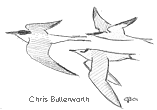|
The Dee Estuary Voluntary Wardens Bird Report 2001 | ||
|
Systematic list -
Black-legged Kittiwake
Rissa tridactyla
Common Tern S. hirundo Summer visitor First :- 6 March 15th Peak count :- 121 August 20th Last :- 3 September 21st. [ The second commonest tern to be recorded from the site, although size of the breeding population further up the river should result in much higher numbers on the shore. The first birds, last year, were seen on May 9th with the last on September 30th. Yet again, the Dee is the third most important site for this species of tern but is a very long way off International Importance.] Arctic Tern S. paradisea Passage First :- 1 March 15th Peak count :- 7 July 27th. + 30th. Last :- 4 September 12th. [The number of birds recorded during the spring was exceptional with a minimum of 75 recorded during the first passage period. Careful checking of migrating tern flocks should reveal many more than are normally noted.] Little Tern S. albifrons Summer visitor First :- 2 May 9th Peak count :- 91 July 21st. Last :- 2 September 3rd. [After a disastrous breeding season this year at Gronant, where just a single young fledged, it is not surprising that all birds recorded from West Kirby were adults. Although this breeding season was equal third in the lowest number of young raised, the overall trend in the area still remains upward with over 100 young being raised in each of four of the last 10 years. The presence of this colony makes the Dee the most important site in Britain for Little Tern and the mean figure for the last five years shows we are only 69 birds away from International Importance. The extreme dates last year were May 12th and September 18th.] Black Tern Chlidonias niger Vagrant 2 August 19th, 5 September 3rd. [Although Black Tern are regularly seen in small numbers from Hilbre we are probably too far inside the mouth of the river for them to be regularly recorded from West Kirby shore. The first birds were recorded flying over the dunes, and were picked up 30 minutes later at Gilroy NP. This was the best year ever, for this species, since the wardening scheme started.] Common Guillemot Uria aalge Scarce visitor Small numbers were recorded, mainly in flight, off Red Rocks from April to October with a peak of c.95 September 30th. [ Guillemot are the commonest auk to be recorded from the wardening site and have, on occasions, be seen on the Marine Lake. This was rather a poor year for records.] Razorbill Alca torda Vagrant 35 past Red Rocks October 28th. was the only report of the year. [This is the first report of Razorbill for the wardens for nearly 10 years. Lack of consistent observer coverage at Red Rocks is probably to blame, as they are recorded frequently off Hilbre and North Wirral.] Atlantic Puffin
Fratercula arctica
Rock Pigeon
Columba livia
|
